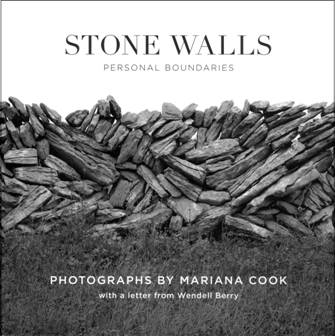
© Mariana Cook
New York City – A new photography book Stone Walls: Personal Boundaries (Damiani, $50, 192 pages, ISBN 978-88-6208-169-6). The book will be published October 1, 2011.
Stone Walls: Personal Boundaries was conceived by Mariana Cook, the last protégé of Ansel Adams, at her home on Martha’s Vineyard on the day before Thanksgiving in 2002. After 56 cows strayed through a crumbling section of the stone wall she shares with her neighbor, Cook studied the tumbled wall and was struck by its beauty. With that inspiration, Cook spent eight years traveling to farms, towns, and temples in Peru, Great Britain, Ireland, the Mediterranean, New England, and Kentucky in pursuit of dry stone walls.
The striking black-and-white photographs portray the wall in landscape, the wall in abstract form, and the return of rocks to nature. Cook is fascinated with the juxtaposition of stones and geometric composition, as well as with the resonance among walls of different cultures. The walls were photographed by Cook between 2002 and 2010 and were built as early as 3600 B.C.
Dry stone walls – those constructed without the use of mortar with stones skillfully selected and placed to ensure strength and durability – are slowly falling into disrepair or being removed from the landscape. Cook writes, “The walls collapse and are replaced by concrete blocks, wire or wooden fences…The self-sufficient family life and closeness bred by the farm is disappearing with its walls.” A portion of the proceeds from the book will benefit The Dry Stone Conservancy in Lexington, Kentucky, a non-profit organization dedicated to preserving historic dry stone structures in Kentucky’s world-famous Bluegrass landscape and to developing a national center for training and expertise.
Among the highlights in the book is Hagar Qim Temple, Malta, 2006, which depicts one of the world’s most ancient religious sites. The oldest dry stone structure on earth, it was built between 3600 and 3200 B.C. Knobs, Hatun Rumiyoq, Cusco, Peru, 2004, shows protrusions carved on 50-ton stones, which were used to drag and position them. (Curiously, every year at noon on the summer solstice, each knob casts a diagonal shadow which ends precisely at the adjacent stone’s corner.) Cook includes a wall by artist Andy Goldsworthy. Jack’s Fold (Andy Goldsworthy’s Sheep Fold), Barbondale, Cumbria, England, 2006, was built in 1996 as part of a series of sheep’s folds. Goldsworthy worked only with existing folds or folds that had been destroyed but were indicated on old maps.
“I love being close to a wall, to stand in front of it for hours, composing an image from the rock’s abstract shapes. It is a pleasure to work in the fresh air, listening to the sheep, cows, and birds. Sometimes, I am caught in the rain and freezing wind, and crouch down next to the wall to take shelter against it as the builders must have done. I feel safe right up against a wall, comforted by its containment of me, perhaps because the boundaries are so clear,” Cook writes.
Among the noted writers of the seven essays in the book are farmer, poet, essayist and author Wendell Berry; Colin Renfrew, British archaeologist and member of the House of Lords; and Thomas B. F. Cummins, Professor of Pre-Columbian and Colonial Art History, and Department Chair, History of Art and Architecture at Harvard University.
As Wendell Berry writes in his essay about stone walls, “They are products equally of art and nature. They look both human and natural.” He concludes that the photographs are “a record of a kind of rural life by now almost lost, but certainly of worth and possibly indispensable.”
Work by Mariana Cook is included in the collections of The Museum of Modern Art and The Metropolitan Museum of Art, New York; the Los Angles County Museum and the J. Paul Getty Museum in Los Angeles; the Corcoran Gallery of Art and the National Portrait Gallery in Washington, D.C.; and the National Gallery and the Victoria and Albert Museum in London, among others. Her previous publications include the acclaimed portrait books: Fathers and Daughters, Mothers and Sons, Generations of Women, Couples, Faces of Science, and Mathematicians. She lives in New York City with her husband and daughter.
Vignette © Mariana Cook

